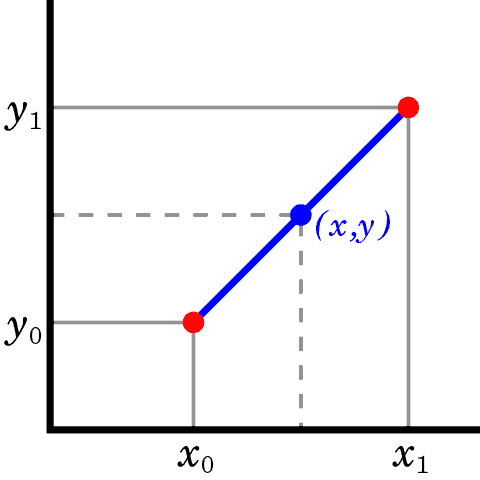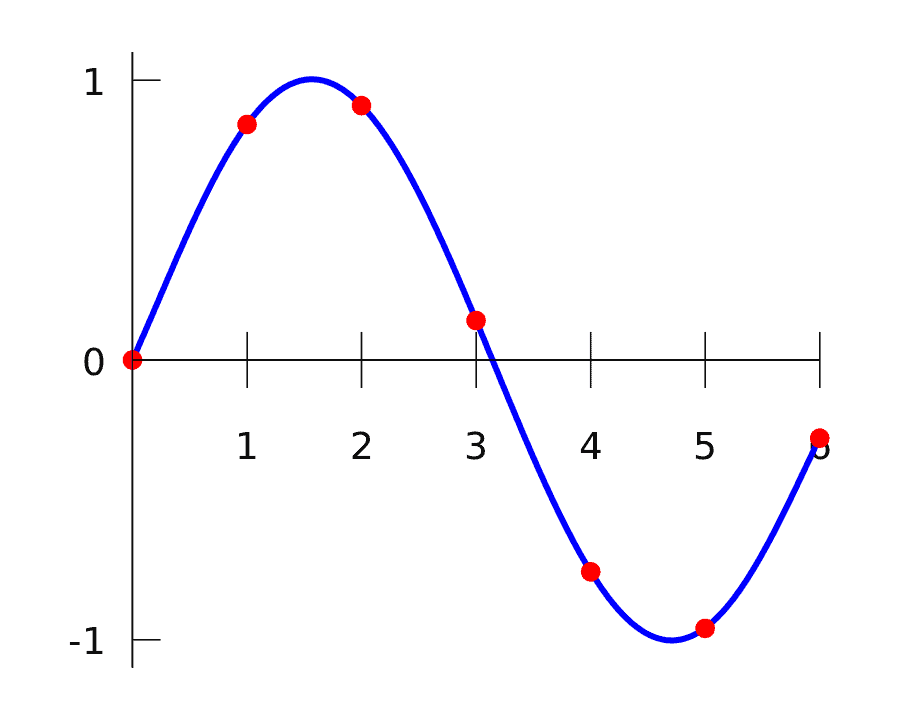1. 插值与回归的概念
插值(Interpolation) 和 回归(Regression) 是数学中两个常见的概念,尤其在数值分析、统计学、金融建模、数据预测等领域应用广泛。虽然两者都涉及对数据点的建模和新值的预测,但它们的出发点和应用场景有显著区别。
在本文中,我们将从数学角度出发,分别介绍插值与回归的核心思想、常用方法,并分析它们的相似性与差异性。
2. 插值的概念
2.1 什么是插值?
插值是数值分析中的一个经典问题,其核心目标是根据已知的一组数据点,构造一个函数,使得该函数完全通过这些点。这个函数可以用于估算这些点之间的未知值。
换句话说,插值关注的是精确通过已有数据点,并据此推测中间点的值。
2.2 常见插值方法
✅ 线性插值(Linear Interpolation)
线性插值是最简单的插值方法,适用于两个点之间的插值。假设我们有两个点:
- $(x_0, y_0)$
- $(x_1, y_1)$
则插值函数为一条直线:
$$ y = a + bx $$
其中:
$$ a = \frac{y_0 x_1 - y_1 x_0}{x_1 - x_0} \quad,\quad b = \frac{y_1 - y_0}{x_1 - x_0} $$
误差估计公式为:
$$ |R| < \frac{(x_1 - x_0)^2}{8} \cdot \max(f''(x)) $$
适用于 $x \in [x_0, x_1]$
下图展示了线性插值的结果(蓝色线):

✅ 多项式插值(Polynomial Interpolation)
多项式插值是将 $N$ 个点拟合成一个多项式函数,这个多项式是唯一的,并且完全通过所有已知点。
一种常见的构造方法是使用 拉格朗日插值公式(Lagrange Polynomial):
$$ p(x) = \sum_{j=0}^{n} y_j \cdot L_{n,j}(x) \quad,\quad L_{n,j}(x) = \prod_{k \ne j} \frac{x - x_k}{x_j - x_k} $$
下图展示了多项式插值对多个点的拟合效果:

✅ 样条插值(Spline Interpolation)
样条插值是一种分段低次多项式插值方法,其中最常见的是三次样条插值(Cubic Spline)。
它的优势在于:
- 插值曲线更加平滑
- 能更好地适应复杂函数形态
- 在端点处具有良好的数学性质(如二阶导数为零)
相比拉格朗日插值,样条插值在实际应用中更为稳定,尤其适合高维数据。
3. 回归的概念
3.1 什么是回归?
回归是统计学中用于分析变量之间关系的一种方法。它的目标是通过一组数据点,拟合一个函数,从而预测或解释因变量(dependent variable)与自变量(independent variables)之间的关系。
与插值不同的是,回归并不要求模型函数必须通过每一个数据点,而是寻找一个“最佳拟合”的函数,使得整体误差最小。
3.2 常见回归方法
✅ 线性回归(Linear Regression)
线性回归是最基础的回归方法,它假设因变量 $y$ 与自变量 $x$ 之间存在线性关系:
$$ y = a + bx + \varepsilon $$
其中:
- $a$ 是截距
- $b$ 是回归系数
- $\varepsilon$ 是随机误差项
下图展示了线性回归模型(蓝色线)对数据点的拟合效果:

✅ 最小二乘法(Least-Squares Method)
最小二乘法是线性回归中最常用的参数估计方法,其核心思想是:
最小化观测值与预测值之间的平方误差和
设残差为:
$$ \varepsilon_i = y_i - \hat{y}_i $$
则最小化目标函数为:
$$ \sum_{i=1}^{n} (y_i - \hat{y}_i)^2 $$
回归系数 $b$ 的计算公式为:
$$ b = \frac{S_{xy}}{S_{xx}} \quad,\quad S_{xy} = \sum(x_i y_i) - \frac{(\sum x_i)(\sum y_i)}{n} \quad,\quad S_{xx} = \sum x_i^2 - \frac{(\sum x_i)^2}{n} $$
截距 $a$ 的计算公式为:
$$ a = \frac{\sum y_i}{n} - b \cdot \frac{\sum x_i}{n} $$
4. 插值与回归的对比
4.1 相似之处
| 特性 | 插值 | 回归 |
|---|---|---|
| 出发点 | 数学 | 数学/统计学 |
| 数据处理 | 一组数据点 | 一组数据点 |
| 目标 | 预测未知点 | 预测未知点 |
| 精度要求 | 高 | 高 |
| 建模方式 | 函数拟合 | 函数拟合 |
| 支持线性/非线性 | ✅ | ✅ |
4.2 不同之处
| 特性 | 插值 | 回归 |
|---|---|---|
| 学科背景 | 数值分析 | 统计学 |
| 数据准确性要求 | 假设数据准确 | 接受噪声数据 |
| 映射关系 | 一对一 | 一对多 |
| 函数是否通过所有点 | ✅ 必须通过 | ❌ 不一定通过 |
| 误差处理 | 有明确误差界 | 平均误差最小 |
| 应用场景 | 数值积分、微分 | 预测、趋势分析 |
| 函数稳定性 | 对噪声敏感 | 更鲁棒 |
5. 总结
本文系统地介绍了插值与回归的基本概念、常用方法及其异同点:
- 插值 更适用于已知数据点准确、需要精确估计中间值的场景;
- 回归 更适用于数据存在误差、需要建立变量间关系模型并进行预测的场景。
在实际工程中,选择哪种方法应根据数据质量、建模目标和应用场景综合判断。例如:
- 数据点少且精确 → 优先考虑插值
- 数据多且有噪声 → 优先考虑回归
理解两者的本质区别,有助于我们在建模和预测中做出更合理的决策。